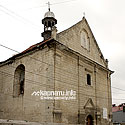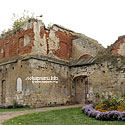Worth seeing in Berezhany
-
Armenian Church
The church of the Nativity of the Virgin Mary with the bell tower was built in 1764. The walls surrounding the complex prove its defensive mission.
A fire of 1810 severely damaged the building. It was restored in 1860.
In the Soviet period there was a granary and a club for farmers here.
Today it is Armenian Church of St. Hryhoriy (Gregory).Address: Berezhany city, Virmenska St. 6 -
The Renaissance Castle was built on the island, washed by river sleeves of Gold Lypa. Synyavski family were the founders of it. It is interesting that the building has a pentagonal shape. It was built during the period of 1534-1554, rebuilt in 1570 and in early XVII c. Then its outer part was strengthened by four bastions. The сastle interiors were decorated with paintings, fabrics, gold and silver. It housed the art gallery and the library.
The castle was visited by August II, a Polish King, Ferenc Rakoczy, the Prince of Transylvania, Ivan Mazepa, a Ukrainian Hetman, Peter I, the Russian Tsar.
After the death of the last member of Syniavski family the castle had been moved from hand to hand. Since the XIX c. the castle has fallen into decay. It served as military barracks, warehouses, a brewery.
The church of the Holy Trinity (1554) is a very interesting sight here. It served as a hop storage. Today the church is under restoration.Address: Berezhany city, I. Franko St. 1 -
Church of St. Nicholas
It is a national monument (XVII c.) of wooden architecture. A beautiful stone gate belfry leads to the church courtyard. Unfortunately, today a large part of the temple has a zinc coating.
The so-called Monument to Sobriety (1878, 1989) is located nearby.Address: Berezhany, T. Shevchenko St. (Adamivka suburb) -
Church of St. Trinity
A new stone church was built in 1748-1768. It combined the Gothic and Renaissance features. After the fire the church was restored in 1810. It got its modern look after the reconstruction of 1893-1908.
The church keeps the relics of John the Baptist. The miraculous icon of Our Lady, Roman, moved from the castle chapel, is a jewel of the temple.Address: Berezhany city, Rynok Sq. 12 -
Fathers Bernardines Monastery
The monastery was built in 1630-1683 by Synyavski family on Storozhysko mountain. It became a symbol of the victory over the Turks at Vienna. It was a defense structure that was connected with the castle by an underground passage.
The church of St. Nicholas built in the Baroque style is the most interestig sight here. It gave the name to the monastery. During the Second World War a school was located in the monastery building, now it houses a prison for juvenile delinquents.Address: Berezhany city, Kostelna St. 1 -
The Virgin Mary Christmas Catholic Church
As a defensive structure, the temple was built on the mountain during 1600-1625. The belfry appeared in 1741. Till nowadays the defense wall with loopholes has been preserved. The white stone portal with coats of arms of Synyavski family is supposed to be created by sculptor Jan Pfister.
The building suffered greatly during the wars of the XX c. During the Soviet period it housed a warehouse, and later — the sports hall.
Now the temple belongs to the Roman Catholic community.Address: Berezhany city, Braty Lepkykh St. 1 -
Town Hall
The building of the modern Town Hall was built in 1803. The clock tower appeared here in 1811. Previously, the magistrate and the gymnasium were placed in the building. And here, in particular, Markiyan Shashkevych and Bohdan Lepky studied.
Today the former Town Hall houses four museums: Museum of Regional Ethnography, Book Museum, Bohdan Lepky Museum, Museum of Sacral Art and Church history.Address: Berezhany city, Rynok Sq. 1
Some other sights
- Building of "Ridna shkola" (local school, 1885), T. Shevchenko St., 1
- Palace (early XIX с.), Virmenska St., 4
- Building of the town council (early ХІХ с.), Bankova St., 4
- Building of the bank office (1910 р.), Bankova St., 6
- Post Office building (early ХХ с.), S. Bandera St., 1
- A. Tchaikovsky's villa (early ХХ ст.), Valova St., 11
- Farther Dubitskyy's villa (1908), Valova St., 20
- Pond (storage reservoir) in Berezhany
- "Devil Stone", source, tract Monastyrok, Lisnyky village
Nature sights
Streets worth seeing
- Rynok Sq.
- Virmenska St.
- Bankova St.

 Ukraine
Ukraine Poland
Poland Slovakia
Slovakia
 Українською
Українською











